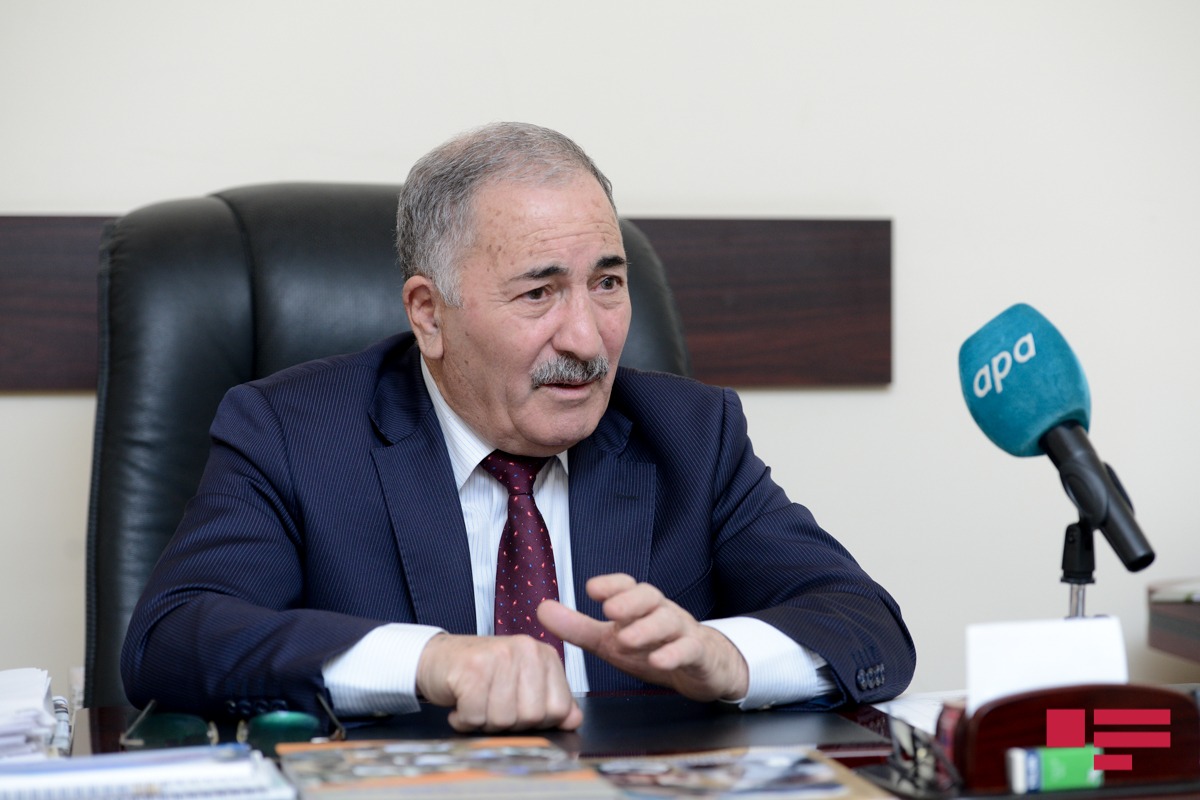Corresponding member of ANAS, Alovsat Guliyev, wrote a long article in “Xalq” newspaper on June 21 of this year, and noted that without any scientific and practical basis, there will be no positive results of the program of the restoration of the Kahriz project.
After that article was published on our website, Vladimir Georgiyev, that head of the Azerbaijani representative office of the International Organization for Migration, contacted our editorial office and informed about the work done in this field and denied the shortcomings mentioned in the article.
The representative of the International organization said that, the facts reflected in Alovsat Guliyev’s article do not exist and that the scientist slandered the organization. In the letter addressed to us by Vladimir Georgiev, there are a number of subtle points that we do not want to mention and create an international scandal.
Frankly, we had certain doubts after the letter sent to our editorial office by the International Organization for Migration. After conducting a short research, we determined that Alovsat Guliyev worked as a scientific consultant in the projects of IOM in 2000-2010, and for the first time he was engaged in the scientific study of Kahriz. Scientist is the author of several books and more than 50 scientific articles on Kahrizes and is a member of UNESCO’s “ Ancient Hydraulic Systems”. After learning these facts about the scientist, such a question aries. Why did Alovsat Guliyev, who is not a well-known scientist, publicize the problem? To clarify the issue, we turned to Alovsat Guliyev, correspondent member of ANAS.
He invited us to visit Agdam region with a commission consisting of various scientists and specialists in order to answer the accusations made in the letter of the Azerbaijan representation of the International Organization for Migration and to prove the truth of the issue he raised.
We agreed without hesitation. Because we were interested in the emergence of the truth as a meida organ that publicizes the facts.
Thus, on July 2, Alovsat Guliyev, a corresponding member of ANAS, Ramiz Mammadov, an employee of the Institute of Geology and Geophysics of ANAS, Doctor of Philosophy in Geology-Minerology Ramiz Mammadov, in 2021 and 2022, the International Organization for Migration restored in Ahmadagali, Mirashelli and Khinderistan villages of Agdam region with the participation of hydrogeologist Saleh Seyfullayev, head of water project with extensive knowledge and experience in this field, and hydrogeologist Rasim Mammadov, chief specialist of the Ministry of Ecology and Natural Resources. After that, the real truths came out.
We had conversations with the executive representatives, mayors and villagers of the settlements that use those kahriz. Those who were asked their opinion on how to restore the kahriz and their previous condition expressed their serious concerns about the restoration of the kahriz and said that they have applied to the relevant state authorities.
First, we got acquainted with "Chinarlı" kahrizi. It turned out that in previous years, the water consumption of the river was 10 l/s, but after the restoration of the IOM, the consumption was less than 0.5 l/s.
While inspecting the "Chinarlı" kahriz, we met and talked with the chairman of Ahmadagali municipality, Fakhreddin Allahverdiyev. The mayor expressed serious displeasure with the method of restoration of the kahriz in this area. We present to the readers what he said as it is: "Why did they tear down my monument and make it like this? In the past, we used the "Chinarlı" canal to irrigate 18 hectares of land, today it is not possible to irrigate even one hectare of land with the canal's water. There is "Shamsi" river nearby. Please go look there. See the water coming? The sandbags were piled in the ground. That's why water doesn't come out. Will it be so?"
Dear Vladimir Georgiyev, we remind you that we do not say these words. Residents of the villages have been using these kahriz for decades.
We said goodbye to teacher Fakhreddin and continued on our way to inspect other kahriz.
Our next address was Khanahmed Kahrizi. The length of this canal is 450 m, the number of wells is 12, the average annual water consumption is 8 l/sec. We learned that the professional specialists of IOM started working here on September 10, 2021, and completed the "recovery" work on November 30, 2021. No engineer - measurement, design and expert review of the project was carried out during the rehabilitation of the canal.
It turned out that the repair or restoration of the dam was not completed until the end. A concrete cover was placed at the mouth of three wells near the exit of the dam. However, during the cleaning of the well, there was no soil-soil spill that had to be removed to the top. Currently, the consumption of water obtained from the well is 0.8 l/sec. The river is about to dry up.
While getting acquainted with the Shamsi river that Ahmadagali municipality chairman Fakhreddin Allahverdiyev talked about, we encountered another sad scene. The "restoration" works here started on February 24, 2020 and ended on December 30, 2020. The length of the canal is 406 m, the number of wells is 16, the annual consumption is 12 l/sec. Here, as mentioned above, three wells have been "repaired and restored". There is no engineering survey or project document for the work carried out in Kahriz. Consumption after "recovery" is 2.5 l/sec.
That is, the water coming out of the kahriz is due to the irrigation water seeping from the surrounding areas rather than the main well. Because no work has been done between the head well and the outlet. Thus, the connection of the water coming out of the kahriz with the main well is not ensured.
On December 1, 2021, "rehabilitation" works were started in the "Gurddu" reservoir, which is 500 m long, has 10 wells, and used to have a multi-year consumption of 8 l/s. Works in this area were completed on January 21, 2022. Apparently, the "specialists" worked here for only 1 month and 20 days.
The time devoted to the work done by the International Organization for Migration in this area under the name of recovery gives a preliminary idea of how it was restored. The outlet and three wells were "repaired and restored" here. Consumption after recovery is 1.5 l/sec.
In the Gozlu district, the "restoration" works started on January 16, 2021, and were completed on August 27 of the same year. The length of the canal is 500 m, the number of wells is 12, the annual consumption is 8 l/sec. The consumption of the pipeline after "recovery" is 0.5 l/sec. "Gozlu" kahriz has also dried up.
We learned that the organization was also involved in the "restoration" of two dams named Heyvali-1 and Heyvali-2 in Ahmadagali village.
The "restoration" works in the "Heyvalı-2" area began on February 23, 2022, and were completed on May 16, 2022. The length of the canal is 350 m, the number of wells is 9, the annual consumption is 10 l/sec. Consumption after "recovery" is 0.5 l/sec.
It should also be noted that, a small architectural complex was created at the exit of the Kahriz, where there was no need to build it, and a tableau showing the activities of the organization was attached to it. It would be good if, in these tables, information about the ancient construction history of the canal, its previous use, and the area it irrigated was also reflected.
The final opinion of the scientists and experts who reviewed the above-mentioned kahriz is as follows:
- Kahrizes are ancient heritage monuments, a reliable water source, and at the same time, they are a hydrotechnical facility based on scientific and technical foundations. Such facilities must be registered as monuments of ancient heritage, they must have a plan, engineering design documents and a passport.
- Before any work is carried out on any embankment, the infrastructure project is drawn up, and after the design-estimate and technical design documents are prepared, they are subject to expert control. After that, restoration work is being carried out in the kahriz. It turned out that IOM does not have any specialists in this field, the works were carried out on the principle of self-reliance.
- In the restoration works, very gross mistakes were made in engineering measurement (leveling) works. Thus, the outlet of the well (main well) is 2-3 meters above the water level in the well. This indicates that water has accumulated in the tunnel of the river and will cause it to collapse. Such activity is observed in all kahriz. In a short time, these kahriz will be completely out of order.
- More serious mistakes were made in the restoration work of the kahriz, which IOM calls "new technology". While the project of the new embankment should be carried out with the help of the modern equipment, the experts of IOM have destroyed another historical monument by carrying out this work on the ancient embankment. That is, this device completely destroyed the gallery while working in the hand-excavated ancient kahriz gallery. However, the new dam should be designed on the basis of modern scientific-theoretical and experimental-hydrogeological principles, and work should be started after passing the expert.
- IOM reported on the restoration of 163 rivers in Azerbaijan. From the observations, it became known that cosmetic works were done in the guise of restoration in the kahriz with constant water. Because the project documents reflecting the land volume, the number of applied products, as well as the work done during the restoration work have not been found.
Thus, the implementation of the "restoration" of our Kahriz , which are ancient heritage monuments, by the IOM without any scientific experience, leads to the destruction of our ancient monuments.
Instead of preserving the antiquity of the exit of the Kahriz , which has a history of a thousand years, unnecessary construction works were carried out there with cement and sawstone. In the next 50-100 years, the construction history of such monuments will be attributed to the 20th century.
In the "restoration" work carried out by the IOM under the name of new technology, we witnessed that plastic pipes were placed in the Kahriz sphere (tunnel) without any engineering measurement, design and drawing materials, and our ancient heritage monuments were destroyed.
After inspecting the dams, experts came to the conclusion that IOM's incomplete restoration work on the dams, which was not based on scientific basis and without any project estimate document, led to the complete failure of the dams.
The facts prove that, the issue raised by Alovsat Guliyev, correspondent member of ANAS, is a serious problem. The fact that, the Azerbaijani delegation of the International Organization for Migration objects to the scientist's opinions and makes noise is nothing more than covering up these cases and self-defense. We invite the international organization to review the restorations of the well-known scientists, experts and media representatives of Azerbaijan. If they object to what we have written, let them show the restored kahriz to the public. Let them explain why they restored these ancient monuments of ours in this form. Nobody should expect us to be indifferent to our history and monuments. We could not remain silent while our thousand-year-old monuments were being destroyed.
We are sure that, after what has been written, the relevant state institutions will be interested in this problem and will not allow the destruction of ancient Kahriz monuments.


















